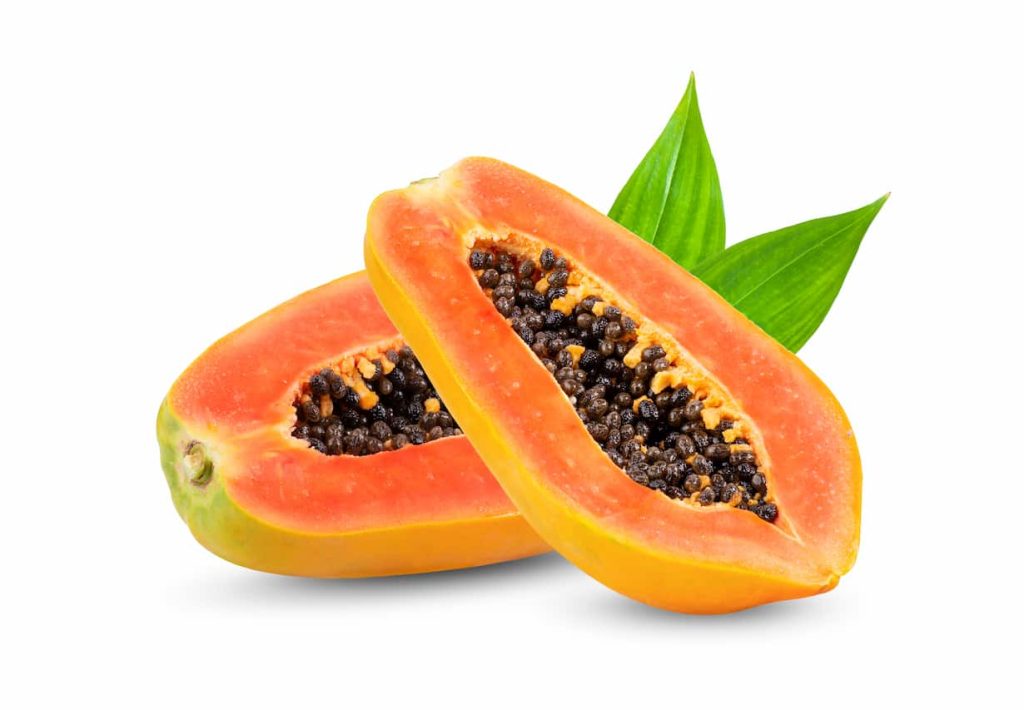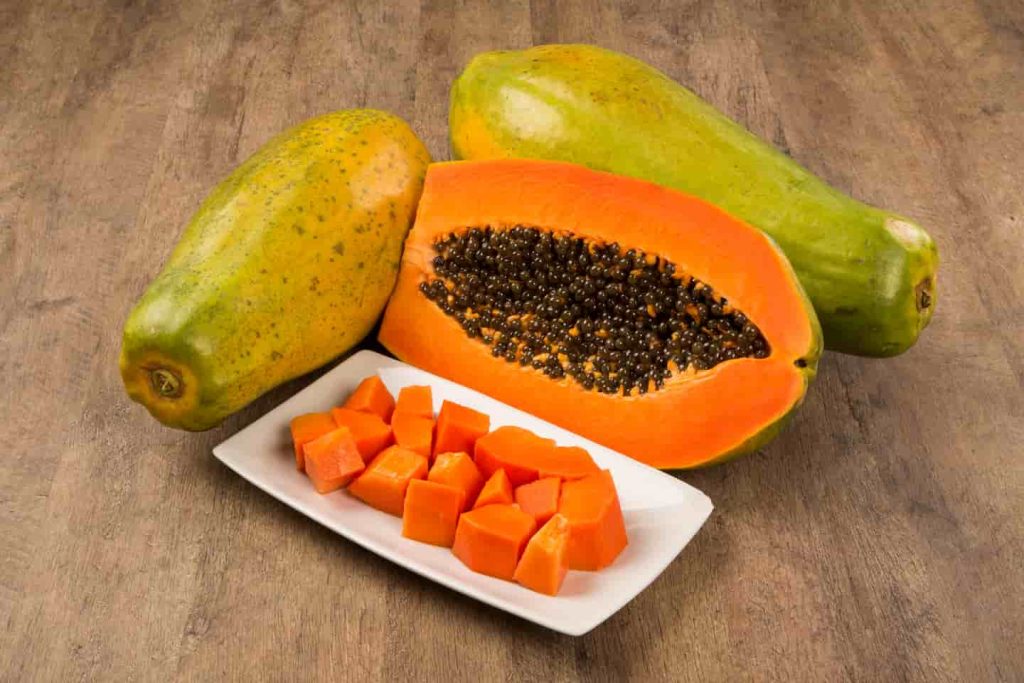NoshQuad Blog Post
What Does Papaya Taste Like
April 03, 2024
Embarking on a papaya adventure, you must ask: have you ever savored this tropical delight? Perhaps, if you have ventured to taste it, the experience might not have been as pleasant as anticipated. Why, you might wonder? A plethora of supermarkets offers these fruits either inadequately ripened or past their prime, leading to a lackluster taste and, at times, a distinct muskiness.
The exquisite taste of papaya hinges on its ripeness. When perfectly ripened, the fruit is a delectable treat. Unfortunately, a multitude of people remains in the dark regarding the ideal ripeness, preparation techniques, enhancing its taste, and discerning spoiled papaya.
What is Papaya?
A tropical gem, the papaya, or pawpaw, flourishes on trees across tropical regions worldwide. This medium-sized, somewhat pear-shaped fruit exhibits an array of colors from green to yellow or vibrant orange, signaling its ripeness. Within the orange interior, large round seeds resembling peppercorns reside. The fruit’s flesh is soft and creamy, exuding a sweet aroma when ripe.
What Does Papaya Taste Like?
Bursting with juiciness, ripe papayas tantalize the taste buds with their sweetness and velvety texture, reminiscent of a tender melon. Conjuring images of a cantaloupe-mango or pumpkin-cantaloupe hybrid, their refreshing taste makes them a popular smoothie addition.
Dare to try the papaya during your next visit to the store, or seek them out in Asian supermarkets. Enjoy!
Where does the papaya come from and where does it grow?

Carica papaya, the botanical name for this remarkable fruit, grows on papaya trees native to Mexico and parts of northern South America. Cultivated in tropical and subtropical regions like the Philippines, Thailand, Australia, and India, papayas have found their way into many countries around the globe.
In the United States, papayas thrive in Hawaii, Florida, Texas, and Southern California. Enthusiasts in Phoenix, Arizona, even grow them in their backyards! Resembling a melon in appearance and varying in size, papayas are, interestingly, botanically classified as berries.
Growing on trees averaging 10 to 15 feet tall, papayas exhibit rapid growth but have a relatively short lifespan, surviving only up to 20 years. They flourish in full sun and well-drained soil within warm to hot climates. Papayas can be grown from seeds or found at nurseries.
What are the health benefits of papaya?
Papaya is known for its many health advantages due to its rich nutrients, which may help protect against different health problems.
Age-related Eye Issues
- Papaya has several health benefits, including preventing asthma and possibly having anti-cancer properties.
- The antioxidant zeaxanthin, in papaya, helps filter out harmful blue light rays.
- This element is believed to help protect eye health and may prevent macular degeneration.
However, eating more fruits overall has been shown to reduce the risk and progression of age-related macular degeneration from trustworthy sources.
Asthma Prevention
Eating more specific nutrients, like beta-carotene found in foods such as papaya, apricots, broccoli, cantaloupe, pumpkin, and carrots, is linked to a lower chance of getting asthma.
Cancer
Eating the antioxidant beta-carotene, in papayas, might lower the risk of cancer. A study in the journal Cancer Epidemiology and Prevention Biomarkers suggests that diets high in beta-carotene could protect against prostate cancer in younger men.
Bone Health
Not getting enough vitamin K is connected to a higher risk of bone fractures. Enough vitamin K is important for overall health because it helps calcium absorption and might reduce calcium loss in urine, leading to stronger, healthier bones.
Diabetes
Research indicates that people with type 1 diabetes who eat high-fiber diets have lower blood sugar levels, while those with type 2 diabetes might see better blood sugar, fat, and insulin levels. A small papaya provides about 3 grams of fiber, equal to just 17 grams of carbohydrates.
Digestion
Papayas have the enzyme papain, which helps with digestion and can work as a meat tenderizer. The fruit is also rich in fiber and water, both of which help avoid constipation and support regularity and a healthy digestive system.
Heart Disease
The fiber, potassium, and vitamin content in papaya all help prevent heart disease. The most important diet changes a person can make to lower their risk of heart disease is to increase potassium intake while decreasing sodium intake.
Inflammation
Papayas are full of choline, an essential and flexible nutrient that supports sleep, muscle movement, learning, and memory. Choline also keeps cell membrane structure, helps nerve signals, aids in fat absorption, and lowers long-term inflammation.
Skin and Healing
When applied to the skin, mashed papaya appears to promote wound healing and prevent infection in burned areas. Scientists believe these benefits come from the enzymes chymopapain and papain in the fruit. Creams with the papain enzyme have also been used to treat bedsores.
Hair Health
Papaya is good for hair because it has vitamin A, a nutrient needed for sebum production, which keeps hair moist. Vitamin A is also needed for the growth of all body tissues, including skin and hair. Enough vitamin C, provided by papaya, is important for making and keeping collagen, which gives structure to the skin.
The nutritional value of papaya
Beyond its delightful taste and effortless snacking appeal, papaya is a nutritional powerhouse packed with vitamins and minerals. The plethora of health benefits include:
- A rich array of nutrients such as vitamin A, vitamin C, and B vitamins.
- Antioxidants in the fruit’s skin prevent oxidation reactions.
- Production of arginine, which benefits the endocrine system.
- Enzymes that aid in alleviating digestive issues.
- Papain is an amino acid that generates human growth hormones for cell rejuvenation and rebuilding of cells, benefitting the liver, bones, and muscles.
- Skin cell regeneration.
- Detoxification of the body.
- Infection prevention in the colon.
- Cold virus prevention.
- Promotion of healthy hair.
- Dried papaya as an aphrodisiac.
Incorporating papaya into your diet regularly not only enhances your well-being and supplies your body with vital nutrients but also adds a touch of zest to your dishes.
Medium-sized papaya has around:
- 120 calories
- 30 grams of carbohydrates – including 5 grams of fiber and 18 grams of sugar
- 2 grams of protein
Papayas are also a good source of:
- folate
- vitamin A
- magnesium
- copper
- pantothenic acid
- fiber
Also, they contain B vitamins, alpha and beta-carotene, lutein and zeaxanthin, vitamin E,
Why Does Papaya Smell Like Vomit?

The enzyme papain, found in papayas, shares similarities with our digestive enzymes, evoking memories of an unpleasant bout of illness. Papain lends a potent, sometimes offensive fragrance to the fruit. Consuming it, however, aids digestion, particularly in breaking down tough proteins. Papaya’s aroma varies in intensity and perception – some remain unfazed and relish the fruit, while others find the smell more tolerable when combined with other fruits or cooked.
What Part Of A Papaya Can You Eat?
Papayas display a color spectrum from green to yellow, with their inner flesh showcasing hues from pale orange to deep salmon. The succulent, flavorsome interior is the primary part consumed. While the skin is technically edible, it is typically discarded, akin to a banana peel. Papaya seeds, though often overlooked, contain significant fiber and nutrients. However, seek medical advice before consuming seeds, as they may pose fertility or health risks.
How To Choose A Ripe Papaya
To experience the most delectable papaya flavor, timing is crucial. Ripeness indicators include skin color, firmness, and aroma. Green skin transforms into a predominantly yellow hue as the fruit ripens. Ensure the skin is free of mold. Assess the papaya’s freshness by checking for bruises or scratches. A ripe papaya exhibits a slightly soft exterior, whereas a firmer texture indicates an unripe fruit. Lastly, a faintly sweet scent signifies ripeness, whereas an absent or overpowering aroma indicates an unripe or overripe fruit, respectively.
How to Keep Ripe papaya fresh?
Upon selecting a perfect papaya, maintain its freshness for a week in a cool refrigerator. Nevertheless, the optimal taste is achieved within the first few days. Underripe papayas should be left at room temperature, resting on a flat surface to avoid mushy spots. To hasten to ripen, place an apple or pear amidst the papayas, ensuring ample space between fruits.
How To Store A Papaya?
Store unripe papayas at room temperature, transferring them to the fridge for up to two weeks once ripened. Refrigerate sliced papaya in an airtight container for 3-4 days, as the fruit continues to ripen and deteriorate, potentially turning mushy beyond this timeframe. If leftovers abound, refrigeration is advised.
How to make papaya taste better?
A perfectly ripened papaya offers the finest taste. Some individuals drizzle honey on the fruit for breakfast, while others blend it into smoothies with bananas, apples, pears, strawberries, blueberries, or raspberries. Incorporating papaya into oatmeal is another popular option. For those seeking alternative consumption methods, dried papaya serves as a nutritious, long-lasting snack, perfect for hikes and other outdoor excursions.
How to Serve Papaya?
For optimal flavor, serve papaya chilled. As the fruit ripens, its yellow hue intensifies and its texture softens. Thoroughly rinse the papaya, then slice it down the middle, akin to a melon. Scoop out the black seeds, which, although edible, are often removed for their less appealing taste. Rinse and reserve the seeds for planting or culinary use, such as grinding for a pepper substitute or incorporating them into dressings. Scoop or slice the papaya flesh and savor its tropical taste.
Recipes Using Papaya

Papaya Lassi Infused with Cardamom
This Indian smoothie traditionally features mango, banana, or other fruits, but here, papaya takes center stage. Blend yogurt, papaya chunks, ground cardamom, milk, and sugar, then refrigerate before relishing this refreshing beverage.
Papaya Bars
In a food processor, blend flour, sugar, butter, and salt until crumbly. Press the dough into a baking dish and bake until the edges are firm. Whisk together papaya puree, eggs, flour, sugar, salt, lemon juice, and honey, then pour the mixture onto the partially baked crust. Bake until the filling sets.
Papaya Jam
Mix papaya chunks, granulated sugar, and lemon juice in a large bowl. Refrigerate for at least three hours, allowing sugar and lemon to break down the papaya. Cook the mixture in a saucepan for 20-30 minutes until the jam gels. Stir in vanilla extract 15 minutes into cooling. Blend the jam with a hand blender and store it in sterilized glass jars.
Papaya Avocado Salsa
This zesty salsa, featuring lime and onion, perfectly complements seafood. Combine onion, lime juice, salt, avocados, papaya, and cilantro in a large bowl, then serve alone or atop grilled fish tacos.
Thai Green Papaya Salad
This traditional Thai salad uses mild-flavored, unripe papaya reminiscent of cucumber. Grind garlic, Thai chiles, palm sugar, cashews, and lime juice in a food processor. Toss julienned green papaya, cherry tomatoes, and halved green beans in a large bowl with the chile and fish sauce mixture. For a vegan alternative, replace fish sauce with soy sauce.
Final Thoughts: What Does Papaya Taste Like
Overlooking papaya’s initial aroma reveals a delectable tropical fruit akin to melon and mango. Papaya’s versatile flavor shines in chutneys, salsas, and fruit salads. For a vegan-friendly, exotic fruit bursting with unexpected taste, give papaya a try and enjoy its freshness.
Papaya FAQs
How would you describe the taste of papaya?
Papaya has a sweet, slightly musky taste with a soft, buttery texture, often compared to melons, mangoes, and bananas.
Does papaya taste like banana?
While papaya has its unique flavor, it is sometimes compared to bananas due to its sweet and slightly musky taste.
What is the best way to eat a papaya?
The best way to eat papaya is ripe, chilled, and sliced, either by itself or in a fruit salad, smoothie, or dessert.
Is papaya an acquired taste?
Papaya’s unique flavor may be an acquired taste for some, but many people enjoy its sweet and refreshing taste immediately.
Related Article
papaya
papaya Recipes
Ripe papaya
you might also like: